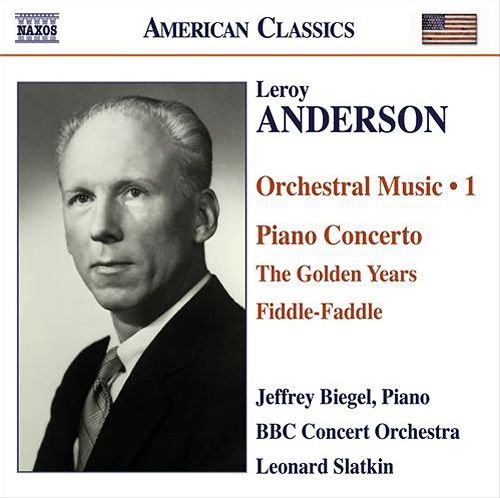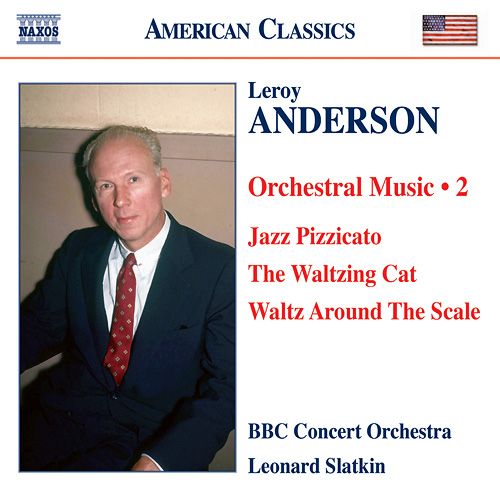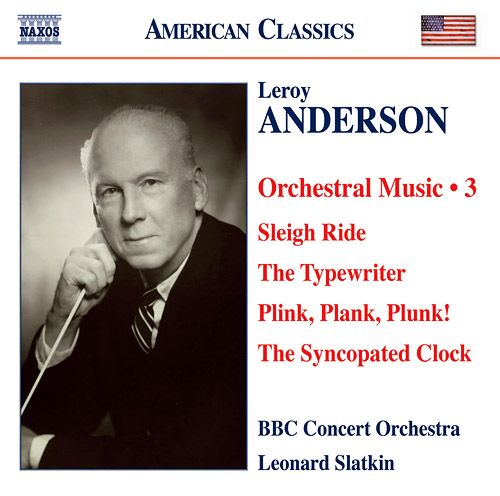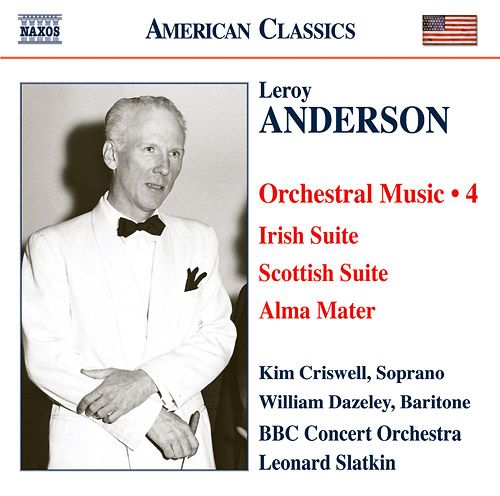(1908-1975) was one of America’s most popular composers of light, melodic orchestral music. A talented conductor and arranger
to boot, he had a particular knack for creating humorous sound effects with standard orchestral instruments and percussion.
Anderson was born June 29, 1908, in Cambridge, MA, into a family of Swedish immigrants. His mother played the organ in
church, and gave her young son lessons; starting at age 11, he studied piano at the New England Conservatory of Music, and
also took private lessons on the double bass. He entered Harvard in 1925 to study music, playing both trombone and double
bass in the orchestra; he also sang in the glee club and joined the marching band as drum major and arranger (some of his
arrangements of collegiate songs are still performed at Harvard). After graduation, he stayed around to earn his master’s
degree, then took a teaching post at Radcliffe College; he also directed the marching band from 1931-1935, performed as
a freelance organist and bassist, and continued his graduate studies in German and Scandinavian languages.
In 1935, Anderson quit his teaching job to become a full-time freelancer. The following year, he was tapped by the Boston
Pops Orchestra to arrange and conduct a medley of his Harvard song arrangements. Director Arthur Fiedler liked Anderson’s
work so well that he requested an original composition, which Anderson delivered in the form of "Jazz Pizzicato." Premiered
in 1938, "Jazz Pizzicato" was a hit with audiences, leading to a follow-up called "Jazz Legato" and a full-time position for
Anderson as the Boston Pops’ arranger and orchestrator. That engagement was interrupted in 1942 by military service;
Anderson spent much of World War II working in the Scandinavian intelligence division, and was eventually transferred
back to Washington as he rose through the ranks. While working at the Pentagon in 1945, Anderson composed one of
his best-known tunes, "The Syncopated Clock"; he premiered it with the Boston Pops that year, along with "Promenade."
When World War II ended, Anderson turned down a full-time intelligence post in Stockholm to return to music. He
rejoined the Boston Pops as orchestrator/arranger from 1946-1950, settling in Woodbury, CT.
During that period, "The Syncopated Clock" was catching on with orchestras and bands across the country. Anderson
began to compose more prolifically, coming up with another popular piece in 1947’s "Fiddle-Faddle", and also
arranging a well-received medley of traditional Irish tunes, "The Irish Suite". In the middle of a particularly hot 1947
summer, Anderson began work on the piece that would become "Sleigh Ride"; completed the following year, the tune
would become a Christmas classic thanks to Anderson’s imaginative sound effects (sleigh bells, clopping hooves, cracking
whips, neighing trumpets, etc.). In 1950, Anderson was offered the chance to lead his own 55-piece studio orchestra by
Decca Records. His recording of "The Syncopated Clock" was soon adopted by CBS as the theme song to its long-lived
Late Show movie program, thus ensuring its immortality. That year also brought two whimsical new hits in "The Typewriter"
and "The Waltzing Cat," both laden with evocative sound effects. 1951 was an even bigger year; "Belle of the Ball"
and "Plink! Plank! Plunk!" took their place in the Anderson canon, but the key item was "Blue Tango," a more
exotic piece that topped the charts and, over 1951-1952, became one of the first instrumentals to sell one million copies.
In 1953, Anderson debuted a more serious, extended classical composition, "Concerto in C for Piano and Orchestra," with
performances in Chicago and Cleveland. He withdrew the work in order to revise the first part, but never completed the intended
changes; his family later published the concerto in its original form. More popular compositions followed in 1954, including
"Bugler’s Holiday," "Sandpaper Ballet" (another effects-oriented piece), and "Forgotten Dreams." In 1958, Anderson
wrote his first and only Broadway musical, Goldilocks, in collaboration with writers/lyricists Walter and Jean Kerr. He recorded for
Decca through 1962, and remained active as a conductor and composer (the latter still primarily for the Boston Pops) into the early
’70s. In 1972, he was the guest of honor on a Pops PBS special devoted to his works. He passed away on May 18, 1975; 13 years
later, he was elected to the Songwriters Hall of Fame. Orchestras across America made Anderson’s catalog one of the most performed
in the country during his heyday; what was more, Anderson wrote different arrangements of his works for musicians of all different
skill levels, helping ensure their accessibility and permanence in the orchestral/band repertoire.
Please request the FLAC link in this thread. Personal messages will be ignored.
Covers & booklets for Volumes 2-5 are included. Limited sharing period.
Music Composed by
Leroy Anderson
Played by the
BBC Concert Orchestra
With
Jeffrey Biegel (piano)
Kim Crisswell (soprano)
William Dazeley (baritone)
Conducted by
Leonard Slatkin
"While American composer Leroy Anderson’s music has never suffered for enthusiasm in concert halls, recordings
of his work significantly declined in the digital era over that of LPs; record companies were satisfied to reissue the older
recordings again and again. One of the best digital recordings of Anderson was The Typewriter: Leroy Anderson Favorites
recorded by Leonard Slatkin and the Saint Louis Symphony Orchestra for BMG. This title still appears to be in print as
Slatkin returns to the scene of the crime with Naxos’ Leroy Anderson: Orchestral Music I, included in Naxos’ American
Classics series. While it does share a few titles in common with the earlier release, more than half of the disc consists
of material that Slatkin did not explore in the BMG title. At least one piece, Governor Bradford March in its orchestral
incarnation, hasn’t appeared on any recording, and certain other pieces included, such as China Doll, Balladette, and
The Classical Jukebox are relative rarities for Anderson. So is his Piano Concerto in C major, which has only been
recorded twice before, once in an arrangement for piano and organ. This composer of "perennial favorites" was
perennially unhappy with his one piano concerto, his only large-scale orchestral composition, and it’s fairly easy
to see why; Anderson thought most successfully in short forms, and his stringing together of episodic ideas to make
up the concerto doesn’t really succeed in coming off as a coherent whole. However, Jeffrey Biegel does play it here
with a sense of enthusiasm and dazzle, and Slatkin complies with a responsive and gracious accompaniment; the
concerto is a very lovely and appealing piece to listen to, in spite of its patchwork construction. Among the lesser-
known pieces, Balladette is rather uncharacteristic for Anderson, with its ominous, rising scale. The Classical Jukebox –
– only lately regarded as an Anderson original, as it is based on the pop song "Music! Music! Music!" — has a skipping
record effect that points up his importance as a progenitor of the art of converting "noise" into music.
No one debates the notion that Leonard Slatkin — even with the decidedly "limey" BBC Concert Orchestra — has a
way with Leroy Anderson; that was one of the things that made BMG’s The Typewriter such a glorious experience.
One additional aspect that made The Typewriter so attractive was its equally glorious sound quality, which plainly is
not in evidence here; the recording is more serviceable than spectacular. Nevertheless, listeners who have already
shelled out for the BMG release may rest assured that they will not be duplicating very much in obtaining Naxos’
Leroy Anderson: Orchestral Music I. Listeners will no doubt be delighted with the range of interesting and unusual
Anderson material offered here."
All Music (Vol. 1)
"The brief Woodbury Fanfare that opens Naxos’ Leroy Anderson: Orchestral Works, Vol. 2, could almost be said
to herald the sound of the floodgates opening, as this disc, performed in expertly idiomatic fashion by the BBC
Concert Orchestra under Leonard Slatkin, introduces five Anderson compositions never before heard on recordings.
Given the relatively high concentration of Anderson’s attention into short pieces, one might get the mistaken
impression — not discouraged by Anderson himself — of a Sunday composer who knocked off pieces here and
there as a form of recreation. Nothing would be further from the truth; he was a notoriously hard-working composer
who also created numerous occasional pieces and arrangements for the Boston Pops that were played once or twice,
tucked in a drawer, and never revisited. These range very widely in expression and purpose; A Harvard Festival
(1969) is a sturdy and solid revision of a work written in the 1930s and based on Harvard student songs. By
comparison, Whistling Kettle (ca. 1966) was an easy piece for strings that formed part of a projected suite, never
finished, entitled The Musical Household. Based around a ciphering E, the piece is strangely nostalgic but
unsentimental, and it comes from the side of Anderson that can roughly be called "experimental" in that it is
equally invested in sound as it is to Anderson’s penchant for delivering memorable tunes.
The balance of the program is made up from Anderson’s less familiar material. Much of it is well worth getting
to know, such as the comical March of the Two Left Feet (1970), the masterful Victorian miniature Horse and
Buggy (1951), and the Suite of Carols for strings (1955), one among a handful of pieces relating to the Christmas
season written for the Boston Pops. Anderson’s music always sparkles with enthusiasm and has that one quality
he never worked without — inspiration — the component that sets Anderson apart from other composers in
his day who were busily cranking out orchestral bon bons for the public. The extent to which Anderson’s creativity
knew no bounds can be awe inspiring to other composers and musicians alike, but for the non-expert listener,
there is an awful lot here to enjoy; the version of Jazz Pizzicato (1938) is especially good. Anderson did all the
work so listeners didn’t have to, and while not all composers are on the same page with such work ethic, it
has helped ensure that Anderson will have listeners for eternity no matter what more seriously applied minds
may think of his work."
All Music (Vol. 2)
"The surprises just keep on coming in Naxos’ excellent Leroy Anderson: Orchestral Works series, of which this
is volume 3, performed, like its predecessors, by the BBC Concert Orchestra under Leonard Slatkin. Some
hardcore Anderson fanatics might recall Alma Mater (1954), a staid and respectful homage to Anderson’s own alma
mater Harvard University. But chances are even they have never heard its predecessor, Harvard Sketches (1939),
which is far more irreverent and striking; the movement "Widener Reading Room" could pass for something
right out of Charles Ives: placid strings are interrupted by the murmuring winds (students) and chastened by
an ever more impatiently rapping ruler. This points up an interesting sidelight about Anderson; while experimental
elements were not entirely foreign to his musical thinking — after all, even pieces like The Typewriter are a little
experimental within its own context — he didn’t really want to be seen that way, so he held the experiments back.
Melody on Two Notes (1966) is another case in point; this piece for student orchestra is based around a motive
of a rising and falling fifth, the rest of it is all in the harmony and orchestration, which envelops the simple figure
in a drapery of lush elegance. Another first-timer is Anderson’s arrangement of George Gershwin’s "Wintergreen
for President" (1932), a depression-era hit from the show Of Thee I Sing. While it is very short, the piece shows
both a mastery of orchestration and a subtle, tongue-in-cheek humor.
The remainder of the disc includes some of Anderson’s most familiar evergreens: Sleigh Ride, The Typewriter,
and The Syncopated Clock, along with worthy if less familiar titles, such as Saraband, Sandpaper Ballet, and the
Suite of Carols for Brass Choir. Slatkin and the BBC Concert Orchestra’s readings are pristine, but are also
spontaneous sounding and never stodgy nor ingratiating in the wrong way. The only thing wrong with this Naxos
project is that even with all of the wonderful new Anderson material included, we’re only to three volumes, and
pretty soon Naxos is going to run to the end of his relatively small catalog. Nevertheless, this series is one of
the best things that has happened to Anderson in posterity; listeners devoted to him ought to regard this
as a first priority."
All Music (Vol. 3)
Source: Naxos CDs (my rips!)
Format: FLAC(RAR), DDD Stereo, Level: -5
File Size: 1.22 GB (incl. covers & booklets for Vol.2-5)
Please request the FLAC link in this thread. Personal messages will be ignored.
Covers & booklets for Volumes 2-5 are included. Limited sharing period.
Enjoy! Don’t share! Buy the originals! 🙂
PLEASE send me links!
Thanks a lot!
*****
Link received. Thank you again!
Thank you very much.
Thanks very much for sharing!!
Please send a link for me.
Thank you.
Alistair
Thanks!
Thanks a lot.
I hope I’m not too late. I would love to get the flac link please. Thank you.
Thanks in advance
Alex
thanks very much!
Many thanks in advance!
I’m interested. First time I hear about Leroy Anderson
*****
Link received. Thank you very much for re-sharing!!!
Thank you again for such continuously wonderful music!!!!!!!!!!
Great SHARE, Thanks in advance !
Received, thank you!
Thank you in advance.
Abita
Would you please be able to send me the links to this?
Troy
Thanks for the share and the interesting information about Anderson.
—————–
Link received, thank you very much.






